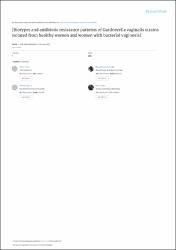| dc.contributor.author | Tosun, İlknur | |
| dc.contributor.author | Alpay Karaoğlu, Şengül | |
| dc.contributor.author | Çiftçi, Hasan | |
| dc.contributor.author | Buruk, Celal Kurtuluş | |
| dc.contributor.author | Aydın, Faruk | |
| dc.contributor.author | Kılıç, Ali Osman | |
| dc.contributor.author | Ertürk, Murat | |
| dc.date.accessioned | 2020-12-19T20:05:49Z | |
| dc.date.available | 2020-12-19T20:05:49Z | |
| dc.date.issued | 2007 | |
| dc.identifier.citation | Tosun, I., Alpay Karaoğlu, S., Ciftçi, H., Buruk, C. K., Aydin, F., Kiliç, A. O., & Ertürk, M. (2007). Sağlikli ve bakteriyel vajinozlu kadinlardan izole edilen Gardnerella vaginalis suşlarinin biyotiplendirilmesi ve antibiyotik direnç durumlarinin belirlenmesi [Biotypes and antibiotic resistance patterns of Gardnerella vaginalis strains isolated from healthy women and women with bacterial vaginosis]. Mikrobiyoloji bulteni, 41(1), 21–27. | en_US |
| dc.identifier.issn | 0374-9096 | |
| dc.identifier.uri | https://hdl.handle.net/11436/3490 | |
| dc.description | PubMed: 17427549 | en_US |
| dc.description.abstract | As Gardnerella vaginalis is accepted as a member of normal vaginal flora, it is one of the dominant species which has been related to bacterial vaginosis (BV). The aim of this study was to determine the isolation rate, biotypes and antibiotic resistance patterns of G.vaginalis from the vaginal swab samples of 408 women who were admitted to the outpatient clinics of Family Planning Center. Hippurate hydrolysis, lipase and ?-galactosidase tests were performed for biotyping the isolates, and agar dilution (for metronidazole) and disk diffusion (for clindamycin) tests were used for the detection of antibiotic resistance patterns. As a result, by Nugent's BV scoring protocol, 122 (29.9%), 20 (29.4%), 137 (33.6%), and 18 (4.4%) of the women were diagnosed as BV, intermediate form, normal vaginal flora (NVF) and mycotic vaginosis, respectively. The overall isolation rate of G.vaginalis was found as 23% (94/408). Of them, 56.4% (53/94) and 8.5% (8/94) were isolated from samples of BV cases and subjects with NVF, respectively, and the difference was statistically significant (p<0.05). The biotyping results showed that the most, frequently detected types were biotype 1 (44%), 5 (20%) and 4 (18%). There was no statistically significant difference between the biotype distribution of BV patients and the subjects who have NVF (p=0.687). The results of antibiotic susceptibility tests indicated that 70% and 53% of the isolates were resistant to metronidazole and clindamycin, respectively. It was of interest that MIC values for metronidazole was ?128 ?g/ml in 57% of resistant strains. The data of this study has emphasized that the metronidazole resistance is very high in our population, and the large scale studies are needed to clarify the relationship between BV and G.vaginalis biotypes, which can be found in the normal vaginal flora. | en_US |
| dc.language.iso | tur | en_US |
| dc.rights | info:eu-repo/semantics/openAccess | en_US |
| dc.subject | Antibiotic resistance | en_US |
| dc.subject | Bacterial vaginosis | en_US |
| dc.subject | Gardnerella vaginalis | en_US |
| dc.title | Biotypes and antibiotic resistance patterns of Gardnerella vaginalis strains isolated from healthy women and women with bacterial vaginosis | en_US |
| dc.title.alternative | Sağlikli ve bakteriyel vajinozlu kadinlardan izole edilen Gardnerella vaginalis suşlarinin biyotiplendirilmesi ve antibiyotik direnç durumlarının belirlenmesi | en_US |
| dc.type | article | en_US |
| dc.contributor.department | RTEÜ, Fen - Edebiyat Fakültesi, Biyoloji Bölümü | en_US |
| dc.contributor.institutionauthor | Alpay Karaoğlu, Şengül | |
| dc.identifier.volume | 41 | en_US |
| dc.identifier.issue | 1 | en_US |
| dc.identifier.startpage | 21 | en_US |
| dc.identifier.endpage | 27 | en_US |
| dc.relation.journal | Mikrobiyoloji Bulteni | en_US |
| dc.relation.publicationcategory | Makale - Uluslararası Hakemli Dergi - Kurum Öğretim Elemanı | en_US |


















